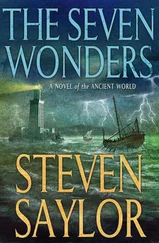The local people of the east coast had once succeeded in putting a warning on the rock. In the fourteenth century, it was said, a man called John Gedy, the abbot of Aberbrothock, was so concerned at the numbers who perished there that he set out to the rock with his monks and an enormous bell. With incredible ingenuity, they attached the bell to the rock and it rang out loud and clear above the waves warning all seafarers, an invisible church in the sea.
The good abbot, however, had not reckoned on human avarice. Soon after, a Dutch pirate called ‘Ralph the Rover’ stole the bell, in spite of its miraculous power to save life by its insistent warning ring. Ironically, he died within a year and must have regretted his act when his ship met bad weather and the great reef, and some said a deserving fate, as he and his ship disappeared beneath the waves. From that time, the rock acquired its name and became known as the ‘Bell Rock’.
The coast of Scotland is long and rugged and has many jagged peninsulas and rocky islets. Even by the late eighteenth century for hundreds of miles, according to local accounts, these desolate shores ‘were nightly plunged into darkness’. To help further the safety of these coastal waters, the Northern Lighthouse Board was established in 1786 to erect and maintain lighthouses. At that time, the warning lights to shipping were often no more than bonfires set on dangerous headlands, maintained by private landowners. When the warning fires were most needed in bad weather, they were usually put out by drenching rain.
By 1795, the board had improved on these primitive lights with seven major lighthouses, but progress was slow. They were chronically underfunded, though never short of requests to do more by worried shipowners, and especially to put a light on the Bell Rock. The Northern Lighthouse Board was well aware of the desirability of a light on the rock. Its reputation as a killer lying in wait at the entrance to the enticing safety of the Firth of Forth had travelled well beyond England. However, with little in the way of funds and the difficulties of building so far out to sea on a rock that was submerged by up to sixteen feet of water for much of the day, such a request was improbable madness not even to be considered.
There was one man, however, who had been dreaming of the impossible, of building a lighthouse on the hidden reef and allowing the whole bay of the Firth of Forth to be useful as safe anchorage. Robert Stevenson was a man of strong character who by some strange fate had been given the very opportunities he needed to fulfil his ambition. In early life his chances of success had looked poor. His mother, Jean Stevenson, had been widowed and left penniless when he was only two. Years of hardship followed, but Jean Stevenson, a deeply religious woman, struggled on to ensure an education for her son. In later life, Stevenson always remembered ‘that dark period when my mother’s ingenious and gentle spirit amidst all her difficulties never failed her’.
Jean was eventually remarried in November 1792 to an Edinburgh widower called Thomas Smith who designed and manufactured lamps. At the time, Smith was interested in increasing the brightness of his lamps. A scientific philosopher from Geneva called Ami Argand had recently developed a way of improving brightness by fitting a glass tube or chimney around the wick. Smith was experimenting with taking this work further by placing a polished tin reflector behind and partly surrounding the wick, shaped in a parabolic curve to focus the light. This gave a much brighter beam than conventional oil lamps and the lamps from his workshops were now much in demand. He was soon approached by the Northern Lighthouse Board, who employed him as their lighting engineer. At a time when lighthouses were as basic as a fire or torch on top of an open tower or simple oil lamps encased in glass lanterns, Smith began to design oil lamps with parabolic reflectors consisting of small facets of mirror glass to create a powerful beam.
When the young Robert Stevenson visited his stepfather’s workshop, he found it a magical place where uninteresting bits of metal and glass were transformed into beautiful precision-made objects. Jean could see where her son’s interests lay and, much to his delight, Stevenson was soon apprenticed to Thomas Smith. One of Thomas Smith’s duties at the Northern Lighthouse Board was to visit the board’s growing number of lighthouses. During the summer months he and Stevenson would set out by boat and appraise the situation, repairing damage and deciding on the position of new lighthouses. By about the turn of the century this responsibility fell entirely to Stevenson.
‘The seas into which his labours carried the new engineer were still scarce charted,’ his grandson, Robert Louis Stevenson, wrote years later.
The coasts still dark; his way on shore was often far beyond the convenience of any road; the isles in which he must sojourn were still partly savage. He must toss much in boats; he must often adventure on horseback through unfrequented wildernesses; he must sometimes plant his lighthouse in the very camp of wreckers; and he was continually enforced to the vicissitudes of out door life. The joy of my grandfather in this career was strong as the love of woman. It lasted him through youth and manhood, it burned strong in age and at the approach of death his last yearning was to renew these loved experiences.
From May to October, Stevenson went on his round visiting the board’s scattered lighthouses, taking much needed supplies and solving problems. These could vary from the repair of storm-damaged buildings to the question of finding new pasture for the keepers’ cow. Stevenson was also employed to map out the position of new lighthouses and soon found that some of the inhabitants of the remote islands – who supplemented their income from wrecking – were openly hostile to him.
On one journey in dense fog his ship came dangerously near sharp rocks of the Isle of Swona. The captain hoped to get help towing the ship away from the danger from a village he could see on shore. The village looked dead; everyone was asleep. To attract attention, he fired a distress signal. Stevenson watched in disbelief, as ‘door after door was opened, and in the grey light of morning, fisher after fisher was seen to come forth nightcap on head. There was no emotion, no animation, it scarce seemed any interest; not a hand was raised, but all callously waited the harvest of the sea, and their children stood by their side and waited also.’ Luckily a breeze sprang up and the ship was able to make for the open sea.
During these summer trips Stevenson learned a great deal. He could be impatient, not inclined to suffer fools gladly, but he never lacked confidence in his ability to tackle the most difficult problems. Over these years, as the Scottish coastline and its lighthouses became ingrained on his mind, he was nurturing his secret ambition to tame for ever the awful power of the Bell Rock. The fulfilment of his dream seemed remote. Stevenson was not a qualified civil engineer. As Smith’s young assistant he had little influence with the board. And he was only too aware that the commissioners believed that a light on the Bell Rock was out of the question.
Those living on the northeast coast of England and Scotland in December 1799 saw the old century dragged out with a thunderous storm of screaming winds and mountainous seas, which raged from Yorkshire to the Shetlands. All along the east coast, ships at anchorage were torn from their moorings and swept away. Those seafarers who could hear anything above the wind and crash of waves listened for the dreaded sound of wood cracking and splitting as it was thrown against rock – the sound of death. In Scotland, the haven of the Firth of Forth, guarded by the Bell Rock, was ignored. Ships preferred to make for the open sea and take their chances in the storm rather than try to steer their way past the dreaded reef. The storm lasted three days and was to sink 70 ships.
Читать дальше












